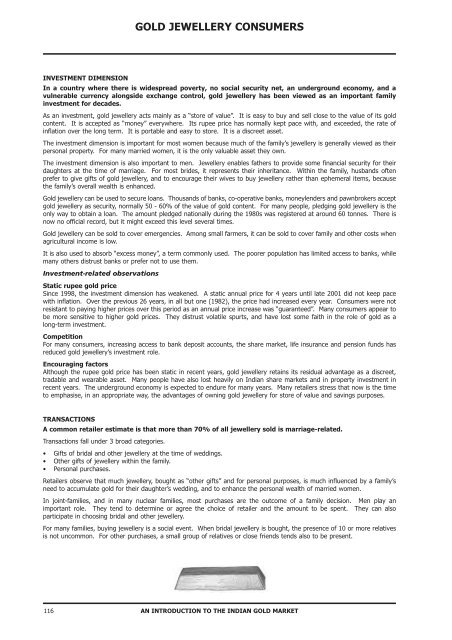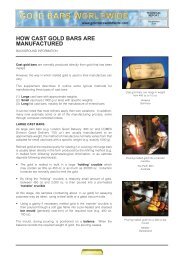Indian Gold Book:Indian Gold Book - Gold Bars Worldwide
Indian Gold Book:Indian Gold Book - Gold Bars Worldwide
Indian Gold Book:Indian Gold Book - Gold Bars Worldwide
You also want an ePaper? Increase the reach of your titles
YUMPU automatically turns print PDFs into web optimized ePapers that Google loves.
INVESTMENT DIMENSION<br />
In a country where there is widespread poverty, no social security net, an underground economy, and a<br />
vulnerable currency alongside exchange control, gold jewellery has been viewed as an important family<br />
investment for decades.<br />
As an investment, gold jewellery acts mainly as a “store of value”. It is easy to buy and sell close to the value of its gold<br />
content. It is accepted as “money” everywhere. Its rupee price has normally kept pace with, and exceeded, the rate of<br />
inflation over the long term. It is portable and easy to store. It is a discreet asset.<br />
The investment dimension is important for most women because much of the family’s jewellery is generally viewed as their<br />
personal property. For many married women, it is the only valuable asset they own.<br />
The investment dimension is also important to men. Jewellery enables fathers to provide some financial security for their<br />
daughters at the time of marriage. For most brides, it represents their inheritance. Within the family, husbands often<br />
prefer to give gifts of gold jewellery, and to encourage their wives to buy jewellery rather than ephemeral items, because<br />
the family’s overall wealth is enhanced.<br />
<strong>Gold</strong> jewellery can be used to secure loans. Thousands of banks, co-operative banks, moneylenders and pawnbrokers accept<br />
gold jewellery as security, normally 50 - 60% of the value of gold content. For many people, pledging gold jewellery is the<br />
only way to obtain a loan. The amount pledged nationally during the 1980s was registered at around 60 tonnes. There is<br />
now no official record, but it might exceed this level several times.<br />
<strong>Gold</strong> jewellery can be sold to cover emergencies. Among small farmers, it can be sold to cover family and other costs when<br />
agricultural income is low.<br />
It is also used to absorb “excess money”, a term commonly used. The poorer population has limited access to banks, while<br />
many others distrust banks or prefer not to use them.<br />
Investment-related observations<br />
GOLD JEWELLERY CONSUMERS<br />
Static rupee gold price<br />
Since 1998, the investment dimension has weakened. A static annual price for 4 years until late 2001 did not keep pace<br />
with inflation. Over the previous 26 years, in all but one (1982), the price had increased every year. Consumers were not<br />
resistant to paying higher prices over this period as an annual price increase was “guaranteed”. Many consumers appear to<br />
be more sensitive to higher gold prices. They distrust volatile spurts, and have lost some faith in the role of gold as a<br />
long-term investment.<br />
Competition<br />
For many consumers, increasing access to bank deposit accounts, the share market, life insurance and pension funds has<br />
reduced gold jewellery’s investment role.<br />
Encouraging factors<br />
Although the rupee gold price has been static in recent years, gold jewellery retains its residual advantage as a discreet,<br />
tradable and wearable asset. Many people have also lost heavily on <strong>Indian</strong> share markets and in property investment in<br />
recent years. The underground economy is expected to endure for many years. Many retailers stress that now is the time<br />
to emphasise, in an appropriate way, the advantages of owning gold jewellery for store of value and savings purposes.<br />
TRANSACTIONS<br />
A common retailer estimate is that more than 70% of all jewellery sold is marriage-related.<br />
Transactions fall under 3 broad categories.<br />
• Gifts of bridal and other jewellery at the time of weddings.<br />
• Other gifts of jewellery within the family.<br />
• Personal purchases.<br />
Retailers observe that much jewellery, bought as “other gifts” and for personal purposes, is much influenced by a family’s<br />
need to accumulate gold for their daughter’s wedding, and to enhance the personal wealth of married women.<br />
In joint-families, and in many nuclear families, most purchases are the outcome of a family decision. Men play an<br />
important role. They tend to determine or agree the choice of retailer and the amount to be spent. They can also<br />
participate in choosing bridal and other jewellery.<br />
For many families, buying jewellery is a social event. When bridal jewellery is bought, the presence of 10 or more relatives<br />
is not uncommon. For other purchases, a small group of relatives or close friends tends also to be present.<br />
116<br />
AN INTRODUCTION TO THE INDIAN GOLD MARKET

















